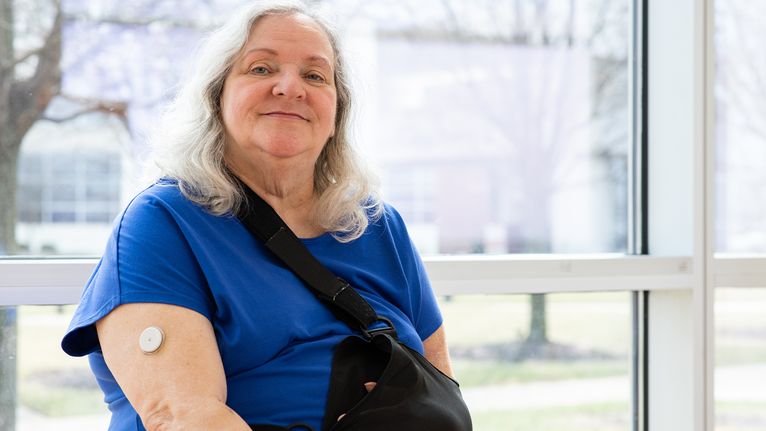Shoulder Surgery: A Helpful Solution for Multiple Problems
Yvonne Brateman, age 67, was feeling hungry one evening and wanted to drive to a local restaurant to grab some dinner. With meteorologists predicting snow earlier in the day, Yvonne decided to check the forecast before she ventured outdoors. As Yvonne walked to her front door to look outside, she unexpectedly tripped on a box, fell face-first toward the floor and struck her left shoulder on the arm of the couch—leaving her unconscious.
When she came to, she was in severe pain and could not move her left arm. She used her right arm to crawl to the wall where she began to beat on the heater, yelling for someone to help her. The man who lived above her heard her cries for help and called 911.
Emergency medical services arrived, placed her into the ambulance and transported her to a local hospital. The emergency staff there gave her a sling for her arm and sent her home.
Still in intense pain the following day, Yvonne sought out a second opinion from UC Health orthopaedic specialists on the West Chester Campus.
Melissa Summers, MD, a UC Health orthopedic surgeon and assistant professor of orthopaedic surgery at the University of Cincinnati College of Medicine, reviewed her X-rays.
“Her fracture was definitely on the very severe end of the spectrum,” Dr. Summers recalled. She admitted Yvonne to UC Health’s West Chester Hospital and immediately scheduled a reverse total shoulder replacement surgery.
“She said she had never seen a shoulder as crushed as mine,” Yvonne remembered. “The socket, everything, was just splintered.”
Shoulder Surgery for Arthritis
Reverse total shoulder replacement can be used for patients like Yvonne who sustain shoulder fractures with multiple pieces. It is also used for patients with shoulder arthritis whose rotator cuff is no longer functioning.
How Reverse Total Shoulder Replacement Surgery Works
“We reverse the mechanics of the shoulder—we place the socket on the ball and the ball on the socket and flip it, allowing for the deltoid—the muscle forming the rounded contour of the shoulder— to power the arm,” Dr. Summers said. The shoulder is replaced with plastic and metal.
“In contrast, a total shoulder replacement restores the patient's native anatomy,” she added. “Because their rotator cuff is still intact.” In either case, the shoulder is replaced with metal and plastic. “These surgeries are used because the patient’s cartilage has worn away and the bones are rubbing together,” Dr. Summers stated, “causing significant pain and disability with daily activities.”
Shoulder replacement is typically reserved for patients who have not improved with non-operative forms of treatment, like physical therapy, injections and anti-inflammatory medications.
Surgery for a Frozen Shoulder
Dr. Summers also treats patients who suffer from adhesive capsulitis, more commonly known as frozen shoulder, where the shoulder becomes painful and freezes, or starts to lose motion. While it is commonly seen in 40-to-60-year-old women who have diabetes or thyroid disease, it can happen to anyone.
“Frozen shoulder actually responds very well to conservative management with physical therapy and injections,” Dr. Summers said, “but it can take several months to improve.” In some cases, surgery may ultimately be the best option.
Physical therapy and injections are also effective to treat impingement, which is the earliest stage of rotator cuff disease.
“Bony spurs start to pinch on the rotator cuff and inflames the fluid sack of the rotator cuff,” Dr. Summers explained, and these patients complain of lateral shoulder pain. Eventually, patients may develop rotator cuff tears and arthritis, which may require arthroscopic surgery. Surgeons use a tiny camera, called an arthroscope, to examine and repair the tissues in and around the shoulder joint.
Surgery for a Dislocated Shoulder
Dr. Summers typically treats younger patients who have problems caused by injuries. A fall can dislocate the glenohumeral joint—the main shoulder ball-and-socket joint—causing recurrent instability. It can also separate the acromioclavicular, or AC joint, which is one of four joints that make up the shoulder. Surgery can restore function and reduce pain through repair reconstruction.
“My philosophy is to start with a conservative approach and allow the patient to help guide their care management,” Dr. Summers explained about her reservation for surgery as a last-resort option. When surgery ultimately has to be performed, it is an incredibly rewarding job for Dr. Summers.
“It stood out to me in medical school that I could spend just a couple of hours in the operating room and make patients exponentially better,” she said. “It’s instant and tangible, and my patients are extremely happy.”
While Yvonne is still building back strength in her shoulder through physical therapy, she is already pleased with the results that she sees.
“Dr. Summers is the most wonderful surgeon I have ever known,” Yvonne beamed. “If anyone I know breaks anything, I am definitely going to recommend her.”
Discover More
To receive the name of an orthopaedic and sports medicine specialist on the UC Health West Chester Campus, please call 513-298-DOCS (3627).
